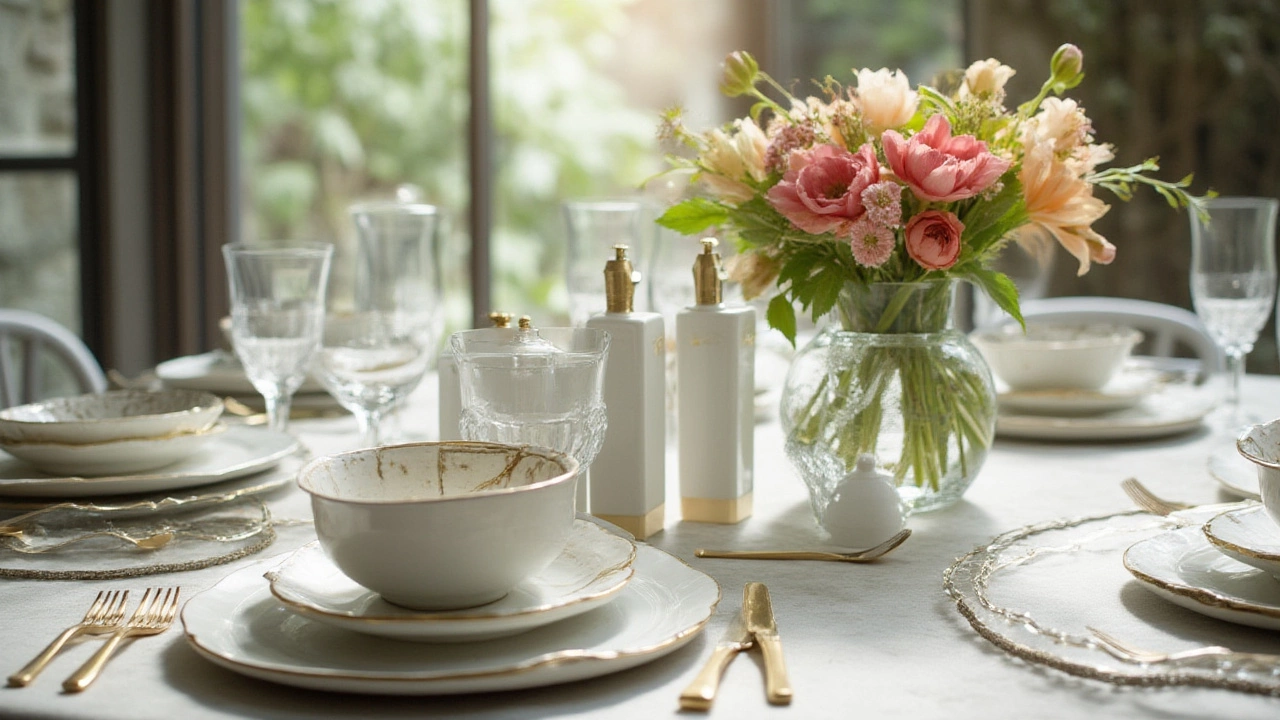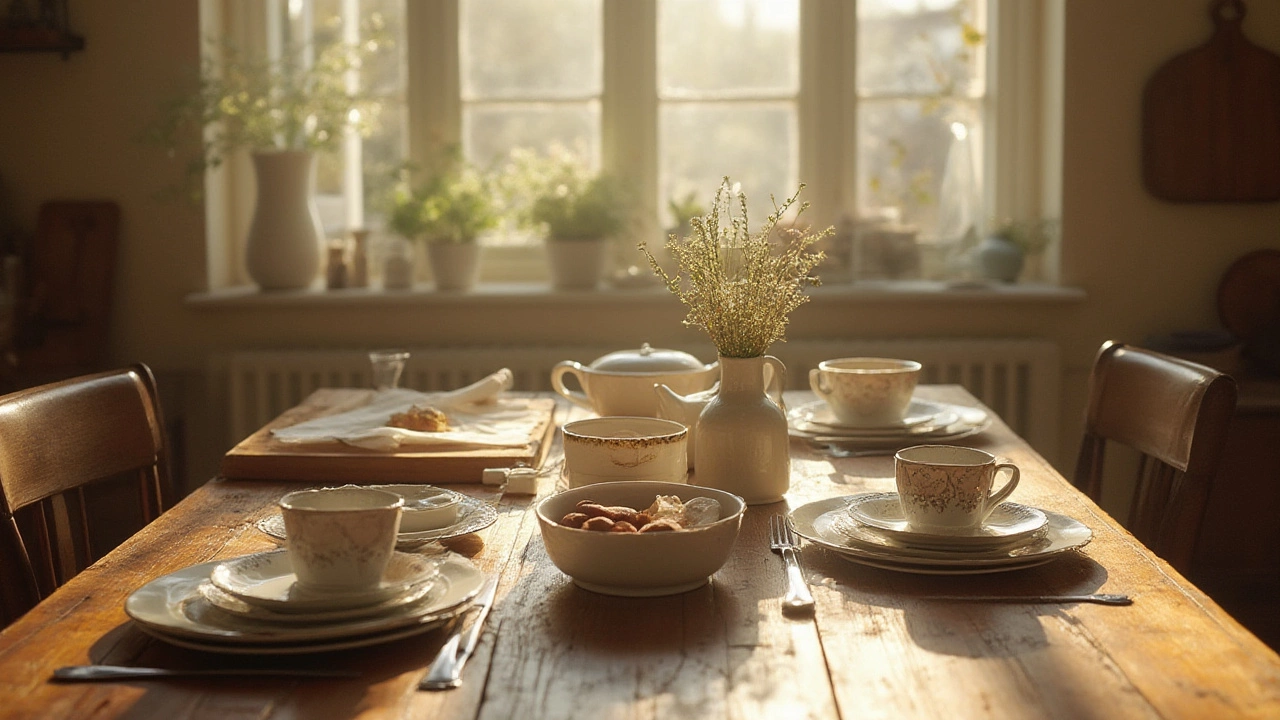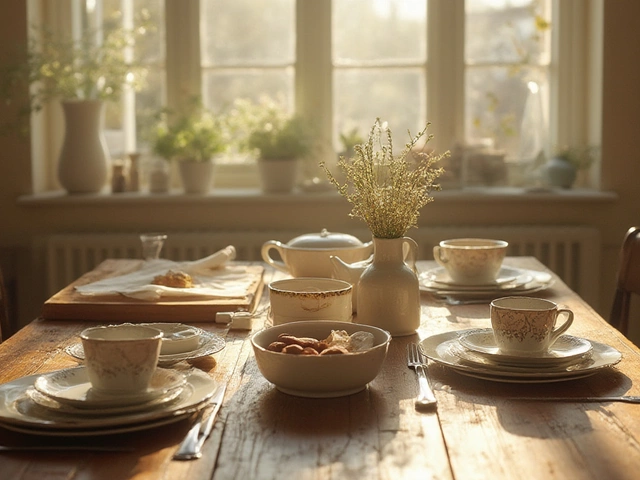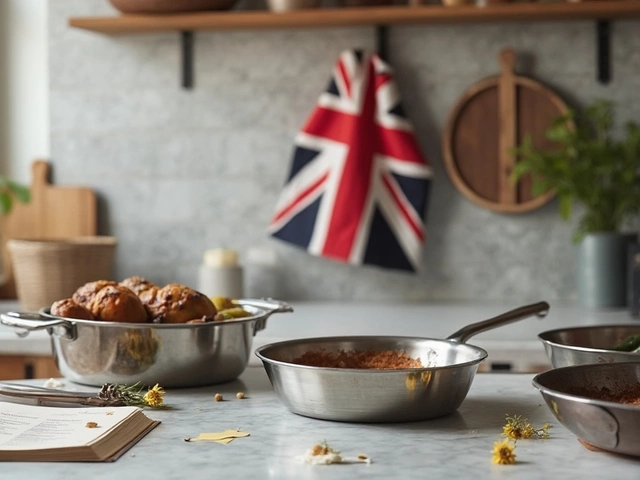Ever noticed how the right plate can make your meal look fancier? Or how a sturdy, sharp knife makes slicing that stubborn butternut squash less of a workout? Tableware and kitchenware are the unsung heroes of any home, quietly shaping the way we cook, eat, and even feel about our meals. While these terms get tossed around in store aisles and gift registries, most people can't quite put their finger on everything they include—or why they matter beyond the basics. Let’s break down what makes each special, why having the right pieces boosts your daily kitchen game, and toss in some quirky facts to keep things interesting.
What's the Difference? Tableware vs Kitchenware
The words sound similar, and yes, they both live in your home’s food zone. But they’ve got their own turf. Tableware, also called dinnerware, is everything you use to serve and eat food at the table. Think plates, bowls, cups, glasses, and the cutlery you use daily—your forks, knives, and spoons. Tableware is all about presentation and comfort, turning basic meals into mini-events. Kitchenware, on the other hand, is all about prepping, cooking, and storing. It’s the pots and pans, ladles, spatulas, colanders, mixing bowls, storage containers, chopping boards—the stuff behind the curtain that gets the meal on the table in the first place.
It’s a little like theater: kitchenware is the hardworking crew making things happen offstage, while tableware is up front, helping the food steal the spotlight. A chef’s knife? Kitchenware. A shiny charger plate under your entrée at a wedding banquet? Tableware. The difference also shows up in materials and designs. Tableware often swaps practical plain for pretty patterns, fine finishes, and delicate materials like porcelain or glass. Kitchenware gets sturdy—think stainless steel, silicon, or heavy-duty plastic, often built to survive heat, cold, and you dropping it after a rough day.
And here’s a quick fun fact: The oldest known tableware comes from ancient China—those iconic blue-and-white porcelain plates that now grace many a family dining room, first showed up over a thousand years ago. Kitchenware goes even further back. Stone knives and clay storage pots found buried in ancient caves tell stories spanning tens of thousands of years. It makes you realize: we’ve been trying to prep, store, and serve food better since forever.
Tableware Types: Not Just Plates and Cups
When was the last time you actually thought about the type of bowl you were eating your soup from? Or the difference between a salad fork and a dessert fork? Tableware can get specific. Dinnerware is your main set: dinner plates (for mains), salad plates (smaller, for side salads or desserts), soup bowls, cereal bowls, and side plates. Drinkware covers glasses—wine glasses (yes, shape does matter), water tumblers, cups for coffee and tea, and even the saucers underneath them. Flatware, sometimes called silverware or cutlery, is forks, knives, spoons, plus all their quirky cousins: fish forks, soup spoons, steak knives.
Some families go wild and collect themed tableware sets for holidays—Halloween pumpkin bowls or novelty Santa mugs, for example. And let’s not forget serving ware, which truly earns its keep during big family gatherings. Large serving bowls, platters, pitchers, gravy boats, butter dishes—these pieces are like the supporting cast at a Thanksgiving or Christmas feast.
Material matters too. Porcelain and bone china scream elegance and are great for fancy dinners, but they’re not always kid-proof. Stoneware is tough and microwave-safe, and melamine is your best friend at picnics or pool parties—nearly unbreakable and lightweight. Even stainless steel plates have made a comeback for outdoor or minimalist dining. Glassware, meanwhile, does double duty: it looks sophisticated but can also show off a great cocktail or layered dessert.
- Did you know the world’s largest dinner plate (over 3 meters wide!) was made in Portugal in 2010? It was built for a festival—but probably not great for leftovers.
- If you ever wondered why formal table settings look complex, each piece has a job. Bread plate at the top left, water glass top right, forks go to the left of the plate, knives and spoons on the right. It’s a dance, and once you know the steps, you’ll look like a pro at weddings or fancy events.
- Pro tip: White plates make food colors pop and can boost appetite, so restaurants use them more than patterned ones.

Kitchenware Essentials: Prepping, Cooking, and Storing Right
Walk into any kitchen supply store and you might get dizzy from all the gadgets. But at its core, kitchenware boils down to tools that help you prepare, cook, and store food. Here’s a quick look at what most home cooks can’t live without:
- Pots and pans: Frying pans, saucepans, stockpots—different sizes for different tasks. Nonstick pans are everywhere, but if you want to sear steaks, a good cast iron skillet is unbeatable.
- Knives: You really only need three—chef’s knife (for most chopping), paring knife (smaller jobs), and a bread knife (hello, sourdough lovers!).
- Utensils: Spatula, wooden spoon, ladle, tongs, whisk—not all at once, but each shines at the right moment.
- Cutting boards: Wood or plastic? Wood for bread and veggies (gentle on blades), plastic for meats (easy sanitation—into the dishwasher).
- Mixing bowls: Glass, stainless steel, or plastic. Nesting bowls save counter space.
- Bakeware: Even if you don’t bake, a sheet pan works for roasting veggies or reheating pizza. Go for ceramic or glass if you love lasagna.
- Measuring cups and spoons: Especially if you like to try new recipes or bake.
- Storage containers: Glass for leftovers is trendy (because plastic can stain or hold smells), but plastic’s still fine for dry goods in the pantry.
- Strainer/colander: To rinse veggies or drain that pasta without cursing under your breath.
Some kitchenware trends worth watching: Silicone tools (heatproof, non-stick, gentle on cookware), and smart gadgets—think digital meat thermometers or Bluetooth timers. Instant Pots and air fryers aren’t just online fads; busy folks love the way these cut cooking time and energy use. If you’re stuck in a cramped kitchen, stackable or multi-use kitchenware is your lifesaver.
Here’s a quick peek at which kitchenware materials work best for different jobs:
| Job | Best Material | Why |
|---|---|---|
| Boiling pasta | Stainless steel pot | Doesn’t react with acidic foods |
| Frying meat | Cast iron skillet | Holds heat, gives a great sear |
| Chopping veggies | Wood cutting board | Preserves knife blades |
| Storing leftovers | Glass container | No odor, microwave-safe |
| Baking brownies | Ceramic or glass dish | Even heat, looks nice on table |
Even the best kitchenware won’t help if it’s not clean and organized. One game-changer: regular decluttering. If you haven’t used that cherry pitter in two years, maybe it’s time for it to go. You’ll thank yourself every time you actually find the right spatula, right when you need it.
Tips to Choose and Care for Your Tableware and Kitchenware
It’s easy to get overwhelmed by marketing promises—“nonstick for life!” or “chip-proof porcelain!”—but in reality, picking the right pieces is about your lifestyle. Have kids? Pick something unbreakable and dishwasher-safe. Love throwing dinner parties? It’s worth splurging on a pretty set of plates and glasses. Short on space? Stackable, nesting, or collapsible items are your new best friends.
- Mix and match: Don’t be shy—eclectic table settings can be trendy and give your table personality. Combining found pieces or heirlooms with new buys makes things interesting.
- Handle with care: Even dishwasher-safe plates can fade or chip over time. Hand-wash your favorites, avoid harsh scouring pads, and skip microwave use if you’re unsure.
- Storage tips: Stack plates with felt separators to avoid scratches. Store knives in a block or magnetic strip. Use drawer organizers for utensils—no more rummaging for that missing teaspoon.
- Sanitizing secrets: Baking soda and vinegar are gentle ways to deep-clean coffee stains or musty odors out of mugs and containers. Lemon can freshen wooden utensils without leaving weird flavors.
When you’re shopping, don’t skip reading reviews—and if possible, hold the items in your hand. Some glassware is weirdly top-heavy or utensils are uncomfortable in your grip. At the end of the day, if you love how it looks and works in your hands, that’s the real test.
Let’s bust a myth while we’re here: pricey doesn’t always mean better. Some of the most loved kitchen tools are super affordable. That classic Duralex Picardie glass? You’ll find it everywhere from Paris cafés to suburban kitchens—and it usually costs less than your lunch.
And yes, trends change. Matte black cutlery and iridescent glassware are hot this year, but timeless white plates and solid wood spoons will never go out of style. One last tip for fun: buy a set of fun appetizer plates or party bowls for last-minute guests. You’ll look clever and prepared, even if the snacks came straight from the freezer.



